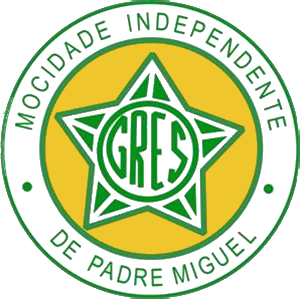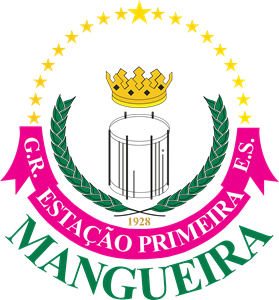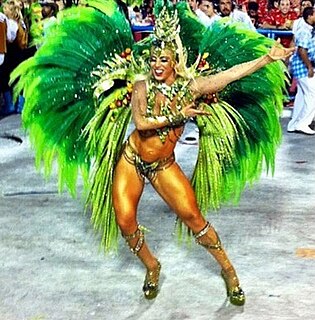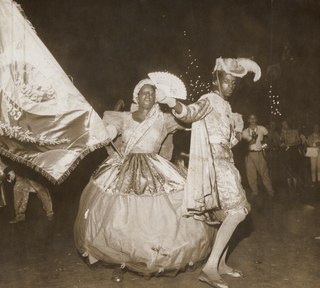
A samba school is a dancing, marching, and drumming club. They practice and often perform in a huge square-compounds and are devoted to practicing and exhibiting samba, an African-Brazilian dance and drumming style. Although the word "school" is in the name, samba schools do not offer instruction. Samba schools have a strong community basis and are traditionally associated with a particular neighborhood. They are often seen to affirm the cultural validity of the Afro-Brazilian heritage in contrast to the mainstream education system, and have evolved often in contrast to authoritarian development. The phrase "escola de samba" is popularly held to derive from the schoolyard location of the first group's early rehearsals. In Rio de Janeiro especially, they are mostly associated with poor neighborhoods ("favelas"). Samba and the samba school can be deeply interwoven with the daily lives of the shanty-town dwellers. Throughout the year the samba schools have various happenings and events, most important of which are rehearsals for the main event which is the yearly carnival parade. Each of the main schools spend many months each year designing the theme, holding a competition for their song, building the floats and rehearsing. It is overseen by a carnavalesco or carnival director. From 2005, some fourteen of the top samba schools in Rio have used a specially designed warehouse complex, the size of ten football pitches, called Samba City to build and house the elaborate floats. Each school's parade may consist of about 3,000 performers or more, and the preparations, especially producing the many different costumes, provide work for thousands of the poorest in Brazilian society. The resulting competition is a major economic and media event, with tens of thousands in the live audience and screened live to millions across South America.

Grêmio Recreativo Escola de Samba Acadêmicos do Salgueiro, popularly known simply as Salgueiro is a popular samba school from Rio de Janeiro, Brazil. It was established on March 5, 1953 from the merger of Morro do Salgueiro's two samba schools called Azul e Branco do Salgueiro and Depois Eu Digo, which then merged again with Unidos do Salgueiro. It first paraded in 1954 with the Romaria à Bahia samba. The school's motto is "Not better, nor worse, just a different school".
Clóvis Bornay was a Brazilian museologist, actor, and maker of Carnival costumes for more than 40 years, which made him famous throughout the nation, and he continues to be honored and the subject at Carnival parades today. He also composed some of the Carnival songs in the 1960s and 1970s and was the costume designer for the Salgueiro parade in 1966; Unidos de Lucas from 1967 to 1969; GRES Portela in 1969 and 1970, where he won at this carnival for his theme "Legends and Mysteries of the Amazon"; GRES Mocidade Independente de Padre Miguel in 1972 and 1973; and lastly Unidos da Tijuca in 1973.

Bangu is a neighborhood in the West Zone of Rio de Janeiro, Brazil. It is a middle-class neighborhood. It is located in the western area of the city being one of the most populated districts, with 244,518 inhabitants [1] distributed in an area of 4570.69 ha. Located in the geographic center of the city, the neighborhood is close to Campo Grande, Senador Camará, Vila Aliança, Padre Miguel and Realengo. On November 22, 2004 the mayor of Rio de Janeiro César Maia created by decree the district Gericinó. The neighborhood was originally part of the neighborhood of Bangu, the region where the penitentiary of Bangu is located, besides Bangu dump. The region is where Gericinó was located containing the sub-district of the Aqueduct. Since 2004, the complex of Bangu and dump of Bangu, no longer belong to the neighborhood of Bangu.

The neighborhood of Padre Miguel is situated in the western region of the city of Rio de Janeiro, is of middle class, and borders the neighborhoods of Bangu (west) and Realengo (east). The Mocidade Independente de Padre Miguel and Unidos de Padre Miguel schools of samba are located in Padre Miguel. On the weekend, another attraction is the Ponto Chic, bohemian stronghold of the neighborhood. Simonsen College and Castelo Branco University, two private colleges, are found in the West Zone. Padre Miguel has many excellent private schools, including Adventist School of Padre Miguel, Prioridade Hum and Simonsen High School.

The Grêmio Recreativo Escola de Samba Mocidade Independente de Padre Miguel is a samba school of the city of Rio de Janeiro, being located on Rua Coronel Tamarindo, in the neighborhood of Padre Miguel.
Liga Independente das Escolas de Samba do Rio de Janeiro, commonly known by the acronym LIESA, is the principal association that organizes the Carnival of the city of Rio de Janeiro.
The Liga Independente das Escolas de Samba de São Paulo - Independent League of the Samba Schools of São Paulo - or LigaSP is an entity that administrates the Special and Access Groups of the Carnival of São Paulo.
The Grêmio Recreativo Escola de Samba Acadêmicos do Grande Rio is a samba school of the Special Group of the carnaval of the city of Rio de Janeiro, being headquartered on Almirante Barroso street in Duque de Caxias.

Grêmio Recreativo Escola de Samba Estação Primeira de Mangueira, or simply Mangueira, is a samba school in Rio de Janeiro, Brazil. The school was founded on April 28, 1928, by Carlos Cachaça, Cartola, Zé Espinguela, among others. It is located at the Mangueira neighborhood, near the region of Maracanã.
The Grêmio Recreativo Escola de Samba União da Ilha do Governador was founded on March 7, 1953 by the friends Maurício Gazelle, and Quincas Orphylo, who were in Cacuia, the main site of the carnival parade of the Ilha do Governador, watching the presentation of small schools of samba and blocks of various districts of the island. It was then decided that the neighborhood of Cacuia should be represented by a samba school. Currently, the school is based in Estrada do Galeão in the neighborhood of Cacuia.

Grêmio Recreativo Escola de Samba Unidos de Vila Isabel is a samba school in Rio de Janeiro. It was thrice champion of the Special Group and is currently headquartered in Boulevard 28 de Setembro in Vila Isabel.
The Liga das Escolas de Samba do Rio de Janeiro is the leading association that organizes the Série A Group in the Carnival in Rio de Janeiro.

Andrea de Andrade is a Brazilian Carnival Queen. She began performing in samba parades in 2006 with Mocidade, a samba school in Rio de Janeiro. In 2010 she won the "Rainha da bateria" of Mocidade and in 2011 led the parade of this school at the Rio de Janeiro carnival.
Grêmio Recreativo Escola de Samba Unidos do Viradouro, or simply Viradouro or Unidos do Viradouro, is a samba school that competes in the Carnival city of Rio de Janeiro. It is located in the Barreto neighborhood in Niterói.

The Grêmio Recreativo Escola de Samba Unidos da Tijuca is a samba school of the city of Rio de Janeiro. It was founded on 31 December 1931 from the fusion of existing blocks in Morro do Borel. Among its founders are Leandro Chagas, João de Almeida, Pacific Vasconcelos, Tatão, Alfredo Gomes, Marina Silva, Orlando da Costa Godinho, Zeneida Oliveira, and Regina Vasconcelos.
Grêmio Recreativo Escola de Samba Unidos do Porto da Pedra is a samba school currently headquartered in the municipality of São Gonçalo. The school was previously located in the city of Rio de Janeiro.

LIESB and ACAS are the alloys of carnival that organize the parades conducted outside the Marquês de Sapucaí. The LIESB took over the organization of the lower level divisions'. In 2015, disagreements on the board of AESCRJ led the organization to suffer intervention by RioTur on the eve of the carnival. because of this, after the carnival that year came the LIESB and Samba é Nosso. where twelve of fourteen guilds of the Série B decide founded the LIESB and part of the samba schools Série B and all schools of Series C, D, E in Samba é Nosso.
This page lists the results of all of the Rio Carnival in the year 2010.

Pedro Ochoro González Alonso Lopez, known as Pedro Alonso, is a Spanish actor, writer and artist. He is best known for his role of Andrés "Berlin" de Fonollosa in the Spanish heist series Money Heist and for the role of Diego Murquía in the historical drama series Gran Hotel. He is also a writer and uses the pen name Pedro Alonso.










